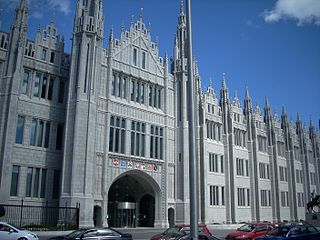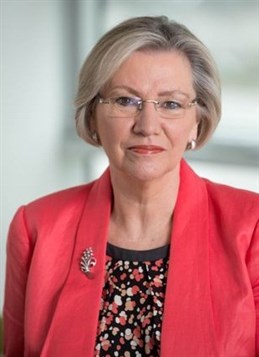Queen's College, Queens' College or Queens College may refer to:
In the United Kingdom (UK), a post-1992 university, synonymous with new university or modern university, is a former polytechnic or central institution that was given university status through the Further and Higher Education Act 1992, or an institution that has been granted university status since 1992 without receiving a royal charter. This is used in contrast to "pre-1992" universities.

The University of the West of Scotland, formerly the University of Paisley, is a public university with four campuses in south-western Scotland, in the towns of Paisley, Blantyre, Dumfries and Ayr, as well as a campus in London, England. The present institution dates from August 2007, following the merger of the University of Paisley with Bell College, Hamilton. It can trace its roots to the late 19th century, and has undergone numerous name changes and mergers over the last century, reflecting its gradual expansion throughout the west of Scotland region.

Glasgow Caledonian UniversityIPA:[ˈɔlhɪjˈxaʎan̪ˠəxˈɣl̪ˠas̪əxu]), informally GCU, Caledonian or Caley, is a public university in Glasgow, Scotland. It was formed in 1993 by the merger of The Queen's College, Glasgow and Glasgow Polytechnic.

Edinburgh Napier University is a public university in Edinburgh, Scotland. Napier Technical College, the predecessor of the university, was founded in 1964, taking its name from 16th-century Scottish mathematician and philosopher John Napier. The technical college was inaugurated as a university in 1992 by Lord Douglas-Hamilton, becoming Napier University. In 2009, the university was renamed Edinburgh Napier University.
MillionPlus, formerly known as million+, the Campaign for Mainstream Universities, and the Coalition of Modern Universities (CMU), is a membership organisation, which aims to promote the role of "modern universities" in the UK higher education system; it describes itself as "The Association for Modern Universities in the UK". MillionPlus is not for profit and funded by subscriptions from its members, currently 23 UK universities. While all of the member institutions are "new" universities, many have long histories as colleges and polytechnics.

Queen Margaret University is a university founded in 1875 and currently located near the town of Musselburgh, East Lothian which is on the eastern outskirts of the city of Edinburgh. It is named after the Scottish Queen Saint Margaret.

There are fifteen universities in Scotland and three other institutions of higher education that have the authority to award academic degrees.
A polytechnic was a tertiary education teaching institution in England, Wales and Northern Ireland offering higher diplomas, undergraduate degree and postgraduate education that was governed and administered at the national level by the Council for National Academic Awards. At the outset, the focus of polytechnics was on STEM subjects, with a special emphasis on engineering. After the passage of the Further and Higher Education Act 1992 they became independent universities, which meant they could award their own degrees. The comparable institutions in Scotland were collectively referred to as Central Institutions.
Margaret Forbes Alexander is a Scottish nurse, educator, researcher and writer. She is emeritus professor at the School of Nursing and Community Health at Glasgow Caledonian University (GCU).

Professor Dame Joan Kathleen Stringer, DBE, FRSE, FRSA is a British political scientist and former Principal and Vice-Chancellor of Edinburgh Napier University and Queen Margaret University, Edinburgh.

Universities Scotland was formed in 1992 as the Committee of Scottish Higher Education Principals (COSHEP) adopting its current name in 2000, when Universities UK was also formed. It represents 19 autonomous higher education institutions, 16 of them with University status and three other higher education institutions in Scotland. The Convener serves a two-year term of office. As of 2024, this post is held by Professor Iain Gillespie, principal of the University of Dundee, while Alastair Sim has served as the organization's Director since 2009.
Kathleen Janette Anderson OBE FRSE FRCC (1927–2002) was a 20th-century Scottish biochemist, highly involved in the transition of Napier College into Napier University.

John Hutchison was a Scottish sculptor based in Edinburgh. He was the son of an unnamed builder, and his artistic life began as a thirteen-year-old woodcarving apprentice. He attended art school in the evenings, then later became a student at the Trustees Academy. and attracted the patronage of its owner, Patrick Allan Fraser, who gave him commissions to fund his study in Rome. Although after Rome he continued to enjoy ancient Roman sculptural themes, he remained in Edinburgh for the rest of his life, working in wood, clay and marble, and concentrating on portraiture of Scottish people, and images of Scottish myth and history. He created the bust of Sir Walter Scott in Poets' Corner in Westminster Abbey. He was a successful artist who received commissions from Queen Victoria.

Education in Scotland in the twentieth century includes all forms of organised education in Scotland, such as elementary, secondary and higher education. The centre of the education system became more focused on Scotland throughout the century, with the Scottish Education Department partly moving north from 1918 and new departments created by the Scottish Executive after devolution.
The 1877–78 Scottish Districts season is a record of all the rugby union matches for Scotland's district teams.